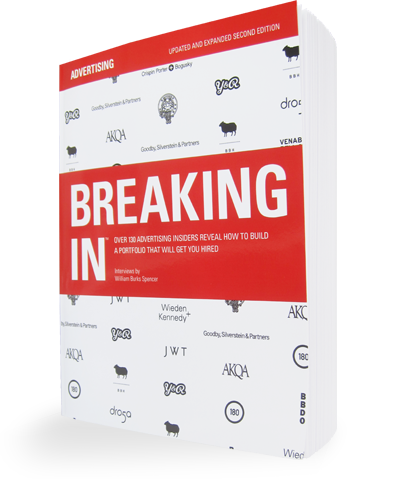In case you missed it, check out some great work from Oliver Voss.
WS: What do you look for in a student book? And what impresses you?
OV: I think I’m old school. I like to receive books that I can either really flip through or look at them on a computer in a way that I see one page after the other—really structured, in a dramatic order. What I don’t like is a website where you have to search your way through…from this project, and then you go back and forth. I really want the book to be well structured and, yeah, give me 10 minutes of entertainment. What I learned in one of the first agencies that I worked in was: start with the best and end with the second-best thing that you have. And I think that’s still true. And then in between, I’m looking for campaigns that work with clients that are not too easy to serve. So if I see a book that only has Tabasco and those kinds of products—condoms, or something like that—then it doesn’t impress me as much as if somebody has a car in it or a washing detergent or something like that.
WS: What do you think of people who are still putting together books that are only print ads? Is print still a good way to demonstrate creativity in advertising, or is it a dying medium that you don’t care about seeing?
OV: Yeah, I still like print ads just as a challenge for creativity, where you just look at a page, and the page is always there, and it’s always the same, and you have the same instruments to work on it. And that doesn’t change and therefore you are always on the same level with everybody else. When photography became popular in art, then the paintings were not valued so high. But now it changes again that people like to paint, and like to look at paintings also. And I think it’s something that will not vanish. And therefore I think if it’s print, or outdoor, this kind of medium, they will always be there. And I like it because you can show your creativity…it shows the creativity of the person who gives me the book quite quickly. With Internet ideas, a lot of the times it takes a long time to explain them: what, and then this happened, and then that happened. So it comes back to the tight schedule that you have when you’re a creative director. And print is a very good tool for that.
And about the book, and it applies to having a presentation with a client: if you have a campaign, you should show your campaign but you should show another, second campaign that advertises, or that sells, your advertising campaign. So in a way, you should put on a show. It doesn’t have to be loud and it doesn’t have to be aggressive or something, but it should be clever and interesting: the campaign that sells your book. So for example, one day I had a car parked next to my spot where I park my car in the morning and it had a message written on it for me or for the creatives here in the company with an email address. And I immediately sent an email to him, to the person who did it, and asked for his or her book. So I think some kind of teaser that’s really made up for the person you want to work with is good. And I’m sure a young person has certain idols. So they might have one, two, or three people who they really want to work for. And I think it’s good to not only send the book, like you send your book to everybody else, but to think of something that targets only this person who you want to work for—your dream creative. I would do that. But then the book has to be good. If you have a shitty book with a second campaign, then it’s a disappointment.
WS: Is there anything else that you want to mention?
OV: I think that it’s important to keep learning and to still always be in the position of the student. For me, at least, that’s the way I work: for every problem that I’m facing and that I want to solve, I solve it as I did when I was starting in the business, at 19 years old, when I had no clue and I just tried to make my way through and to get to the point. And I think to stay humble and to not think too highly of yourself, and that you will solve every problem, helps you. I still have a lot of panic when I receive a brief. Because I start to panic in order to get a solution. And I’m never sure if I will get one. Sometimes I don’t. And to have that feeling of being naïve, and still being at the point when you start something and you don’t know [the answer], that’s very important for everybody and for students as well.

Comments are closed.